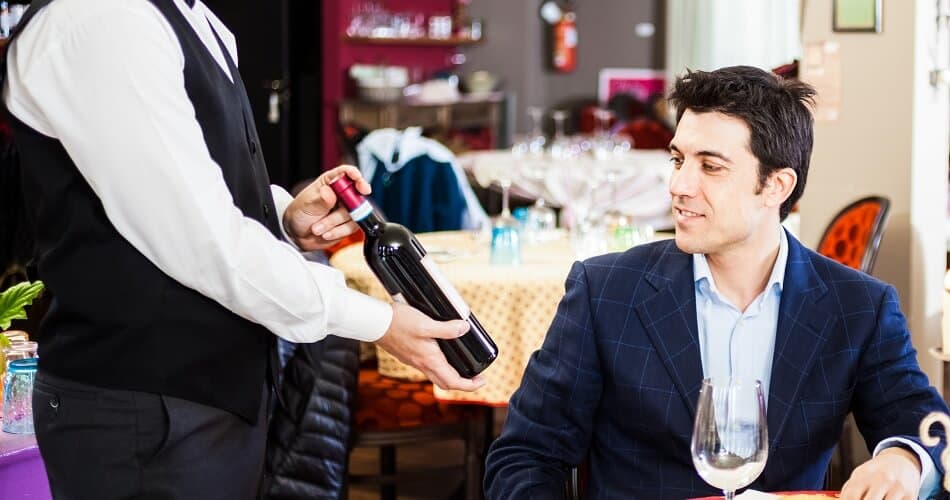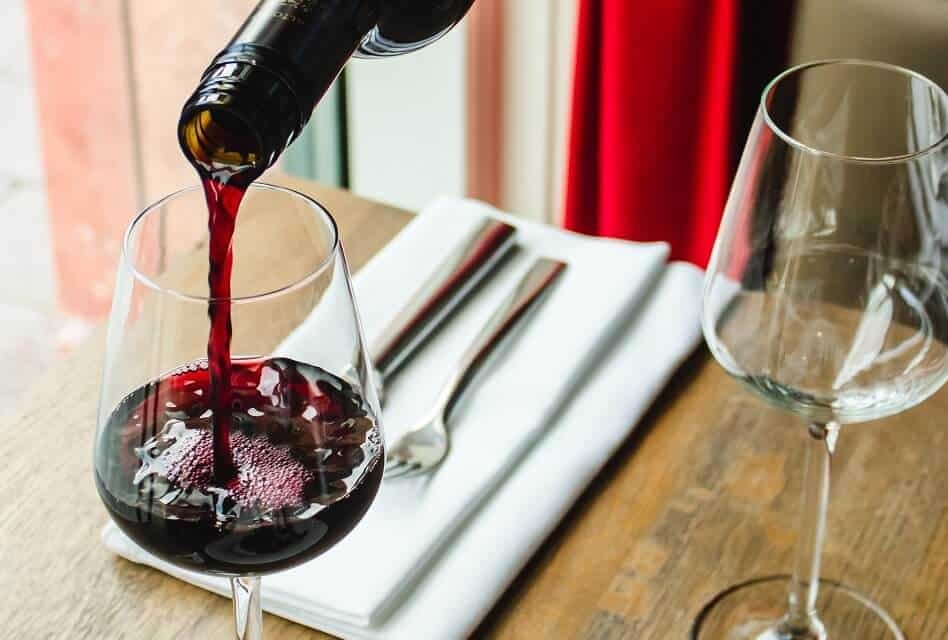For some wine lovers, pouring wine is a kind of ritual. And for people who don’t drink wine regularly, it might come across as odd. From presenting the bottle to pouring to swirling the wine in the glass, this process can be irritating. Especially the fact that waiters pour wine in such small portions, although wine glasses are pretty big, is strange. But what is the reason? Why is wine poured in small amounts?
Wine is poured in small amounts because that helps aerate the wine. As a result, the wine can release its most delicate aromas more easily. Small portions also reduce the risk of the wine heating up too soon and prevent the drinker from getting drunk quickly.
The proper wine pour differs based on the wine type. So depending on your personal preferences, you need to adjust the serving size. Also, other aspects of the pouring process, such as the serving temperature or the need to decant, depend on the wine type. So let us discuss how to pour wine properly in detail.
WHY DO YOU ONLY POUR HALF A GLASS OF WINE?
Wine is poured in small amounts to maximize the wine’s surface in the glass. Usually, waiters pour just enough wine to fill the widest part of the glass. By doing so, they ensure to get more air, or more precisely oxygen, in contact with the wine. This aeration helps the wine release its most delicate aromas and reach its full potential.
That is absolutely crucial for red wines that spend a significant time aging in oak. But white wines benefit from aeration as well. So if you want to enjoy your wine to the fullest, serving only small amounts is key.
Pouring wine in small amounts has other positive effects. Most notably, it is beneficial regarding the serving temperature. The vast majority of wines are best when at least slightly chilled. Serving big portions would increase the risk that the wine heats up beyond the optimal drinking temperature before the drinker finishes it. Or they would force the drinker to consume it very fast. And as wine has alcohol volumes of up to 15%, drinking fast can result in getting drunk quickly.
So, in conclusion, pouring only half a glass of wine helps you enjoy it at the optimal temperature without a hurry and without getting drunk quickly.
WHAT IS A NORMAL POUR OF WINE?
A normal pour of wine is 5 ounces (or 150 milliliters) for both red and white wines. As most wine glasses hold between 12 and 14 oz (350-420 ml), that is less than half a glass.
If your wine is sweet, fortified, or sparkling, the normal pour is even smaller.
| WINE TYPE | NORMAL POUR (OZ) | NORMAL POUR (ML) |
| Red Table Wine | 5 oz | 150 ml |
| White Table Wine | 5 oz | 150 ml |
| Dessert Wine | 2 oz | 60 ml |
| Sparkling Wine | 4-5 oz | 120 – 150 ml |
| Fortified Wine | 2-3 oz | 60 – 90 ml |
| Wine Tasting | 2-3 oz | 60 – 90 ml |
The Normal Dessert Wine Pour
For dessert wines, the optimal serving size is 2 oz (60 ml). As dessert wines are high in residual sugar, they are very sweet. And sweet wines can be overwhelming when coming in big portions. So just like the portions of dessert are smaller than the portions of the main course, the dessert wine pour is smaller than the table wine pour.
Logically, dessert wine glasses are significantly smaller than standard glasses for table wines. A typical dessert wine glass holds 6 to 9 oz (180-270 ml). That means the standard pour fills about ⅓ of the glass at maximum.
The Normal Sparkling Wine Pour
When serving sparkling wine, you should pour 4 to 5 oz (120-150 ml). That equals approximately the optimal serving of still wine. Sparkling wine glasses are much slimmer and thus have a lower capacity, though. Most hold not more than 6 oz (180 ml). So the normal sparkling wine pour fills at least ⅔ of the glass.
The reason for the relatively big serving size is those sparklers do not need aeration. Most styles do not need any oxygen to release their aromas. Contact with air can even be harmful. The bigger the wine’’’s surface, the quicker the bubbles disappear and leave the wine dull and unenjoyable. Thus it’s better to limit contact with air by using slim glasses.
Besides, sparkling wines have lower alcohol levels than still wines. Thus, it is not necessary to limit the poured amount.
The Normal Fortified Wine Pour
The normal pour for fortified wines is 2 to 3 oz (60-90 ml). This amount is comparable to the optimal serving size of dessert wines. That makes sense, as many fortified wines like Port or Madeira also belong to the dessert wine category.
But even those that are not sweet should come in small portions because they are very high in alcohol. Usually, fortified wines have between 15 and 20% vol. Serving big pours of these strong wines would leave your guests drunk in no time.
Glasses for fortified wine are similar in size to dessert wine glasses. They hold 6 to 9 oz (180-270 ml), so you should fill them to about ⅓ of their capacity.
How Much Wine Is Poured for a Tasting?
For a wine tasting, the host usually serves half of the normal wine pour: between 2 and 3 oz (60-90 ml). This reduced serving size makes perfect sense as a tasting’s purpose is to try many different wines. Smaller portions allow wine lovers to do that without getting drunk or being forced to dump large amounts of leftover wine. Nevertheless, a wine pour of 2 to 3 oz is sufficient to inspect the wine properly, including its color, odor, and taste.
While you can use regular-size wine glasses for wine tasting, you can also find special tasting glasses with a lower capacity.
HOW TO POUR WINE WITHOUT OPENING THE BOTTLE?
To pour wine into a glass without opening the bottle, you need a special pouring device. These devices drive a needle through the bottle’s cork and suck a pour of wine out. As they do not damage the cork significantly, the wine inside is still safe from oxidation. And unlike wine in an uncorked bottle, it won’t go bad. So you can enjoy one glass now and another one in a couple of weeks without caring about spoilage.
Systems to pour wine without removing the cork come with a price tag. If you consider getting one of these wine preservation and pouring systems, expect to pay at least a couple hundred dollars. On the other hand, they will spare you the need to finish a bottle in a hurry. Check out the models from Coravin or Plum.
| BOTTLE SIZE | CAPACITY IN MILLILITERS | SERVINGS (STILL & SPARKLING WINE) | SERVINGS (FORTIFIED & DESSERT WINE) |
| Split / Piccolo | 187.5 ml | 1 | 2 – 3 |
| Half / Demi | 375 ml | 2 – 3 | 4 – 6 |
| Half-Liter / Jennie | 500 ml | 3 | 6 – 8 |
| Standard | 750 ml | 5 | 8 – 12 |
| Liter | 1000 ml | 7 | 12 – 16 |
| Magnum | 1500 ml | 10 | 16 – 25 |
| Double Magnum | 3000 ml | 20 | 33 – 50 |
HOW TO POUR WINE LIKE A SOMMELIER
Sommeliers or other wine experts know precisely how wine should be poured to provide a great experience to patrons. They know the optimal serving size and how to pour wine without spilling.
To pour wine like a sommelier, follow these steps:
- Remove the foil from the bottle head. Use either a sommelier’s knife or another sharp household item.
- Open the bottle with a corkscrew. Make sure not to damage the cork. Pieces of cork that fall into the wine create a very unpleasant experience. So you definitely want to avoid that.
- Decant the wine if necessary. Especially for old wines, aeration in the glass might not be enough. These wines need to spend some time in a decanter to breathe and open up.
- Pour a bit of wine into your guests’ glasses. Let them try it to find out whether they like it or not.
- If they approve, add more wine until each guest has a standard serving.

There are some rules to follow when pouring the wine. Here they are:
- Ladies first! Serve your female guests before you fill your male guests’ glasses.
- Always pour wine from the right side (from your guests’ perspective). This the where the glasses stand on the table. So you do not have to lean over your guests when filling them.
- Hold the bottle at the bottom. That allows you to keep an eye on the bottleneck. If you spot sediments in there, immediately stop pouring. Remove the solid parts before you continue.
- Remember that wine is poured in small amounts. Make up your mind about the normal wine pour upfront. If you are unsure, stop pouring when the wine fills the widest part of the glass.
- Pour slowly to avoid spilling wine. When serving sparkling wine, you might need to stop halfway, so it does not overflow. Give the bubbles a moment to settle and continue until the pour is complete.
- Clean the bottleneck with a clean towel or a napkin after pouring, so no leftover wine drips on the table (or worse, on your guests).
FINAL WORDS
The ritual of pouring wine might look odd for newbies, but every aspect has a reason. With the details from this article, you know why wine is poured in small amounts and why wine glasses are never filled completely. So at your next wine party, you will be the perfect host. Have fun!
Recent Posts
Switzerland is famous not only for its beautiful landscapes and its picturesque towns but also for some food items. Especially Swiss cheese and chocolate are world-famous. But do you actually know a...
Winemaking is a sophisticated process that includes multiple steps and can take several years. Depending on the desired wine and the vintner's preferred techniques, these steps can differ. However,...

